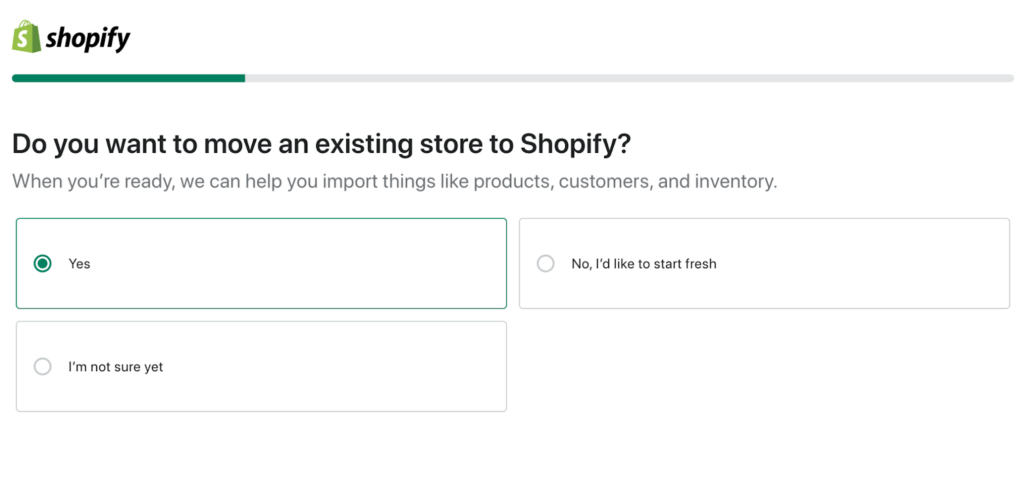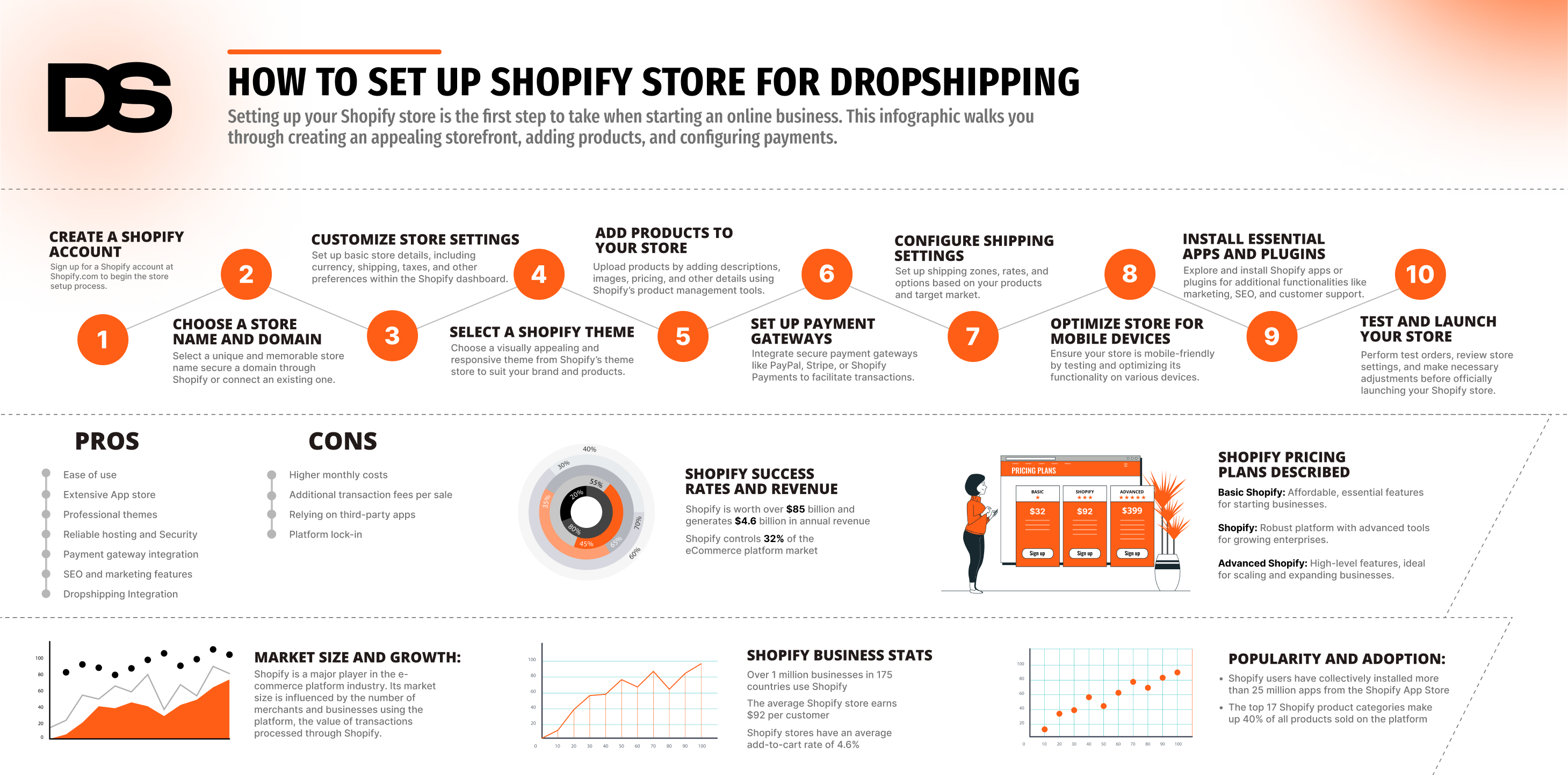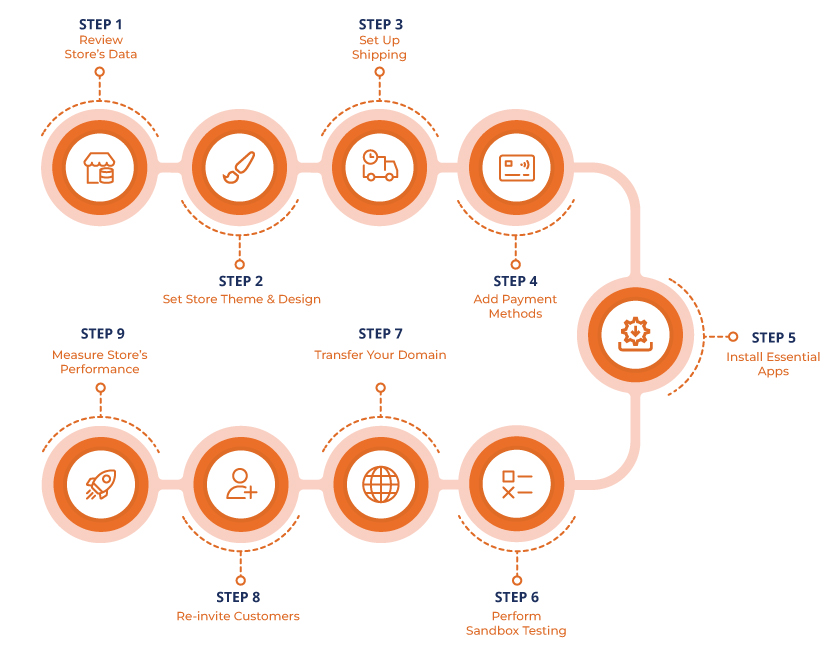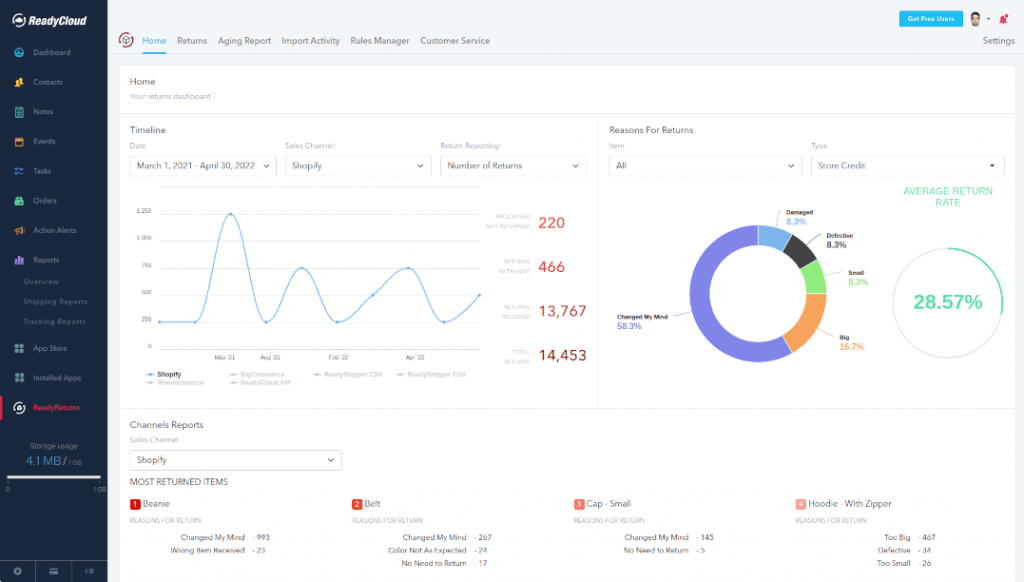Migrating from Amazon to Shopify: A Power Sellers Quick Guide

Switching from Amazon to Shopify might feel overwhelming at first, but it’s a smart decision that can greatly enhance your online business. To help those considering the change, we will explore why taking control of your storefront and sales channels is essential, highlight the advantages of using Shopify, and provide a step-by-step roadmap to ensure a smooth transition. Plus, we’ll show you how ReadyCloud can be your best friend throughout the migration process and give your ecommerce business a competitive advantage.
In this today’s in-depth guide, you’ll learn the essential steps for a successful migration from Amazon to Shopify (including Shopify Plus and Shopify Headless) the challenges you might face, and how ReadyCloud can make the entire process smoother and more efficient.
Why Migrate from Amazon to Shopify?
Switching from Amazon to Shopify can be a game-changer for your online business, offering greater control, customization, and potential for growth. While Amazon provides a robust platform for sellers, it comes with certain limitations and costs that Shopify can help you overcome. In this section, we’ll dive into the key benefits of migrating to Shopify, as well as the challenges you might face along the way.
Customization and Control
- Unique Shopping Experience: Shopify allows you to create a highly personalized shopping experience. You can customize every aspect of your store, from the homepage design to the checkout process.
- Flexible Design Options: Select from an extensive array of free and premium themes, which you can customize to align with your brand’s unique identity. Use Shopify’s drag-and-drop builder or delve into the HTML and CSS for more advanced customization.
- Functionality Tailored to Your Needs: Unlike Amazon, Shopify doesn’t impose restrictions on the functionality of your store. You can implement custom features and integrations to craft a smooth and distinctive customer journey.
Lower Fees
- Budget-Friendly: Shopify generally features reduced transaction fees in comparison to Amazon. Your business can significantly increase profit margins on the same products when sold on your Shopify store.
- Flexible Pricing Plans: Shopify provides various pricing plans starting from basic to advanced, allowing you to choose the one that best suits your business size and needs. As your business expands, you can effortlessly upgrade to a more advanced plan.
- No Hidden Costs: With clear pricing and fewer unexpected charges, managing your budget becomes simpler and more predictable.
Extensive App Ecosystem
- Robust Selection of Apps: Shopify’s app store offers thousands of apps tailored to boost your store’s functionality, including tools for SEO, marketing, inventory management, and customer service.
- Scalability: With the impressive selection of apps, you can add many different capabilities to your online store quickly. This flexibility ensures your store evolves in step with your business needs.
- Integration with Other Tools: Many Shopify apps integrate seamlessly with other business tools you might be using, such as accounting software, CRM systems, and email marketing platforms, ensuring a cohesive business operation.
Challenges of Migration
- Temporary Disruptions: Migrating to a new platform can cause temporary downtime, affecting your sales and customer experience. It’s crucial to plan the migration during off-peak times to minimize disruptions.
- Preparation and Planning: A well-thought-out migration plan can help reduce setup time and ensure a smoother transition. This includes data backups, setting up your new Shopify store, and testing all functionalities before going live.
- Resource Allocation: Allocate sufficient resources, including time, budget, and personnel, to manage the migration effectively and address any issues that arise promptly.
Learning Curve
- Adapting to New Interface: Moving from Amazon’s interface to Shopify’s platform requires learning and adaptation. Although Shopify is user-friendly, transitioning to the platform requires a period of adjustment.
- Training and Support: Utilize Shopify’s extensive support resources, such as tutorials, forums, and customer support, to aid in your transition. Investing time in learning the platform can significantly shorten the learning curve.
- Continuous Improvement: Regularly update your knowledge about Shopify’s features and best practices to continually improve your store’s performance and user experience.
Risk of Data Loss or Inconsistencies
- Data Backup: Before starting the migration, ensure that you have backed up all critical data, including product listings, customer information, and sales history. This prevents loss of important data during the transfer.
- Reliable Migration Tools: Employ dependable tools and services for data migration to reduce the risk of inconsistencies or data loss.Many third-party solutions specialize in migrating data between e-commerce platforms.
- Data Validation: Once the migration is complete, take the time with your team to ensure all information has been accurately transferred. It’s important to make sure that SKUs, product descriptions, sizes, prices, and images all match up correctly.
Migrating from Amazon to Shopify is a strategic move that can provide numerous benefits, including greater customization, lower fees, and access to a vast app ecosystem. However, it’s important to be aware there can certainly be challenges as well, like potential downtime during migration, the learning curve of a new system, and the risk of losing your data.
Preparing thoroughly and leveraging tools like ReadyCloud will help you overcome these challenges and make the most of Shopify’s robust platform. Next, we’ll dive into how to prepare for the migration, ensuring a successful move from Amazon to Shopify.
Preparing for the Migration
Transitioning from Amazon to Shopify requires careful planning and thorough preparation to ensure a smooth process. Evaluating your current Amazon setup and setting clear goals for Shopify, while backing up your data, will mitigate potential challenges and make the migration as seamless as possible.
Here’s how to get started:
Evaluate Your Current Amazon Setup
- Review Current Processes: Start by examining how you currently manage your inventory on Amazon. Document quantities, SKUs, and any unique product attributes that will need to be migrated to Shopify.
- Categorization: Ensure your inventory is well-organized and categorized. This organization will simplify the migration process and help maintain accuracy during the transition.
- Tracking and Inventory Management Systems: Evaluate the systems and tools currently used to track inventory. Think about how these can be adjusted or enhanced in Shopify to ensure smooth inventory management.
Order Fulfillment Processes
- Workflow Assessment: Examine your current order fulfillment workflows from order placement to delivery. Identify key steps that need to be replicated or enhanced in Shopify.
- Efficiency Review: Look for inefficiencies or bottlenecks in your current process. Determine how Shopify’s tools can streamline these operations to enhance efficiency.
- Third-Party Integrations: If you use third-party fulfillment services, check their compatibility with Shopify and plan for any necessary adjustments to maintain service continuity.
Customer Data and Sales Records
- Data Compilation: Gather all customer information and historical sales records from Amazon. This information is essential for preserving customer relationship continuity and analyzing sales trends.
- Data Format and Clean-Up: Ensure the data is in a format compatible with Shopify. Clean and organize the data to facilitate a smooth import process and ensure its accuracy.
Craft Clear Goals for Your Shopify Store
Achieving a seamless transition to Shopify hinges on careful planning and well-defined goals. Outlining your new store with detailed features, processes, categories and integrations will set a solid foundation for success. With strategic budget planning and realistic timelines, you can navigate the migration smoothly, ensuring your new Shopify store thrives.
Set Clear Goals for Shopify: Before you start the migration, outline your specific goals for the new Shopify store. Having clear goals creates a checklist that helps ensure all essential elements are accounted for during the transition.
- Identify Key Features: Determine the features and functionalities you want in your Shopify store. This could include specific apps for marketing, analytics, or enhanced customer service capabilities.
- Customization Requirements: Take some time to review how much customization will be needed for your store’s design and functionality. Identify unique design elements or custom features that reflect your brand’s identity, while remembering that more complicated aspects can be added later.
- Integration Needs: Consider any third-party tools or services currently used on Amazon that you wish to integrate with Shopify. Ensure these integrations are planned for in the migration process.
Budget and Timeline for the Migration: Careful planning of budget and timeline is crucial for a successful migration. This includes covering all potential costs and allocating sufficient time for each phase.
- Budget Planning: Establish a budget for the migration, covering costs for app subscriptions, professional services, and any additional resources required.
- Timeline Creation: Set a realistic timeline for the migration process. Allocate ample time for each phase to avoid rushing and minimize errors.
- Resource Allocation: Assign necessary resources, including personnel and tools, to manage the migration effectively and address any challenges promptly.
Clearly defining your desired features and functionalities while planning for customizations, and ensuring all integrations are accounted for, ensures that you are well-prepared for the migration. What’s more, thorough budget planning and realistic timelines will help manage the transition smoothly, minimizing disruptions and ensuring your new Shopify store is set up for success.
Backup Your Data
Preserving historical sales data is crucial for understanding sales trends and ensuring business continuity during your migration to Shopify. This data not only aids in robust analytics and customer relationship management but also helps streamline accounting, procurement, inventory planning and more. To back up your data effectively, leverage Amazon’s export tools, create multiple backups, and verify the accuracy to safeguard against any potential loss.
Importance of Preserving Historical Sales Data: Maintaining your data integrity is vital for analytics, customer relationship management, and business continuity. Historical sales data helps create projections and craft tailored experiences that keep them ordering from your online store for many years to come.
- Maintain Data Integrity: Preserving historical sales data is crucial for analytics, customer relationship management, and business continuity.
- Compliance: Ensure compliance with any regulatory requirements regarding data preservation and customer information.
Methods for Backing Up Data from Amazon: Properly backing up your data ensures you have everything needed for a smooth transition.
- Export Tools: Utilize Amazon’s tools to export your data. Ensure all critical information, including product listings, customer details, and sales records, is backed up.
- Multiple Backups: Create multiple backups stored in different locations, such as cloud storage, to safeguard against data loss. This redundancy ensures data security and availability.
- Data Verification: After backing up your data, verify its completeness and accuracy to prevent any issues during the migration process.
Thoroughly evaluating your current Amazon setup and setting clear goals for your Shopify store, while diligently backing up your data, lays a solid foundation for a successful migration. It might seem like overkill, but this careful preparation will make sure that your existing business makes a seamless transition and can start driving traffic to your new site as soon as possible.
ReadyCloud’s Role in a Migration to Shopify
ReadyCloud offers a comprehensive software suite specifically designed to support multichannel selling, making it easier for e-commerce businesses to manage multiple sales platforms. With its powerful features tailored for online merchants, ReadyCloud simplifies the complexities involved in handling different sales channels.
How ReadyCloud Helps with Amazon Shopify Migration
Seamless Integration
- Smooth Transition: ReadyCloud seamlessly integrates with both Amazon and Shopify, facilitating a smoother transition between platforms.
- Data Synchronization: It ensures that data is synchronized between Amazon and Shopify, maintaining consistency and accuracy throughout the migration process.
Preservation of Historical Data
- Centralized Data Management: ReadyCloud keeps all your historical data in one centralized location, eliminating the risk of losing important information during the migration.
- Data Integrity: It preserves the integrity of your historical sales and customer data, ensuring that all crucial information is maintained.
Tools for Managing Orders, Customers, and Inventory
- Comprehensive Management Tools: ReadyCloud provides robust tools for managing orders, customer information, and inventory across both Amazon and Shopify.
- Streamlined Operations: These tools streamline your operations, making it easier to handle multiple aspects of your e-commerce business efficiently.
Benefits of Using ReadyCloud
Simplified Migration Process
- User-Friendly Interface: ReadyCloud’s intuitive interface and powerful features make the migration process straightforward and less stressful.
- Ease of Use: Its user-friendly design helps you navigate the complexities of migration with ease.
Enhanced Data Accuracy and Consistency
- Centralized Data Management: ReadyCloud ensures that your data remains accurate and up-to-date across all platforms.
- Consistency Across Channels: This centralization minimizes discrepancies and maintains consistency across your sales channels.
Improved Efficiency in Managing Multiple Sales Channels
- Efficient Multichannel Management: ReadyCloud’s tools help you manage multiple sales channels efficiently, saving time and reducing the complexity of multichannel selling.
- Operational Streamlining: Its features streamline your operations, making it easier to oversee and control different sales platforms from a single dashboard.
Moving From Amazon to Shopify: Step-by-Step Migration Process
Migrating from Amazon to Shopify requires careful planning and execution to ensure a seamless transition. Adopting a systematic approach helps you seamlessly transfer your store with minimal disruption. Here’s an in-depth guide to help you navigate the process:
Initial Shopify Setup
Creating Your Shopify Account:
- Account Setup: Begin by setting up your Shopify account and adding the Amazon Integration Plus. Select a plan that fits your business needs and complete the initial setup process. Shopify offers a free trial that will allow you to start adding products and creating your landing pages. Once you’re ready to get started on a monthly plan, they offer setup support and assistance to help your migration process go smoothly.
Installing Necessary Apps and Plugins:
- Essential Apps: Install vital apps and plugins to boost your store’s functionality and streamline the migration process. Consider tools like ReadyCloud and thousands of other fantastic apps to enhance your store’s capabilities and mimic Amazon and other major retailers.
- Plugin Configuration: Configure the installed apps to match your business requirements and optimize your operations effectively. Youtube is a fantastic resource if the app itself presents challenges. Most Shopify apps have great documentation and lots of users sharing creative tips.

Transferring Data to Shopify
Exporting Product Listings from Amazon
- Data Export: Use Amazon’s tools to export your product listings, making sure all crucial information such as SKUs, descriptions, and images is included.
- Data Preparation: Organize and clean the exported data to match Shopify’s format requirements, ensuring a smooth import process.
Importing Products into Shopify Using ReadyCloud
- Facilitated Import: ReadyCloud streamlines the product import process into Shopify. Follow the provided guidelines to ensure all data is accurately transferred.
- Data Verification: Verify the imported data to confirm that all product listings are complete and accurate.
Migrating Customer and Order Data
- Data Transfer: Move your customer and order data to Shopify to maintain continuity in customer relationships and order management.
- Data Integrity: Ensure that all customer information and order histories are accurately transferred and consistent across the platforms.

Setting Up Your Shopify Store
Crafting a Tailored Store Design:
- Design Personalization: Customize your store’s design to reflect your brand’s unique identity. There are thousands of themes and customization options to make your store stand out.
- Let Your Brand Shine: It’s quick and easy to add key brand elements to the site, such as logos, color schemes, and fonts to create a consistent and cohesive look.
Configuring Payment Gateways and Shipping Options:
- Setting Up Payment Gateways: Configure payment gateways to facilitate smooth transactions. Shopify supports various payment methods to cater to different customer preferences.
Testing the Functionality and User Experience
- Thorough Testing: Perform extensive testing to ensure your store is fully functional. Test every aspect, including the checkout process, navigation, and overall user experience.
- User Experience Optimization: Adjust based on testing feedback to improve the user experience and ensure a seamless shopping journey.
Following these detailed steps will guarantee an effective and efficient transition from Amazon to Shopify. Read on to find valuable post-migration tips to help you optimize your new Shopify store and manage your sales channels effectively.

Post-Migration Tips for Shopify Power Sellers
After successfully migrating from Amazon to Shopify, it’s important to focus on testing, optimizing, and marketing your new store to ensure continued success. Here are some tips to help you maximize the potential of your Shopify store and manage your sales channels effectively:
Testing and Optimization
Conducting Thorough Testing
- Comprehensive Store Testing: Test all aspects of your store, including the checkout process, product listings, and customer accounts. Ensure that everything functions seamlessly and provides a smooth user experience.
- Identifying Issues: Identify any issues or glitches during testing and address them promptly to prevent negative impacts on customer satisfaction.
Assessing and Enhancing Store Performance
Tracking Store Metrics:
- Harness Shopify Analytics: Utilize Shopify’s analytics tools to evaluate your store’s performance. To get a quick start, just start to understand some key metrics like page load times, conversion rates, and upselling to pinpoint areas for enhancement.
- Making Data-Informed Improvements: Use data insights to make informed adjustments. Enhance areas that are underperforming and optimize features that drive positive results, improving overall functionality and user experience.
Marketing Your New Shopify Store
- Engaging with Social Media: Most people in the ecommerce industry are already familiar with the power of social media. Shopify offers some great tools to integrate and grow your social commerce as you spread the message of your wonderful brand and new store on social channels. It should be easier than ever to craft engaging content, promotions, and product updates to attract and retain customers, while making sure all those new orders are organized and fulfilled from your new Shopify store.
Effective Email Campaigns
Enhanced Email Marketing with Shopify and ReadyCloud: Developing targeted email marketing campaigns becomes significantly more effective with the combined power of Shopify and ReadyCloud. Both platforms offer robust tools and integrations to help you reach your audience directly and drive engagement with your customers wherever they are.
Built-In Email Marketing: Shopify offers integrated email marketing tools that enable you to design and send personalized email campaigns effortlessly. You can segment your customer list based on purchase history, behavior, and preferences to tailor your messages for maximum impact. Shopify’s templates and automation features streamline the process, ensuring professional and timely communications.
ReadyCloud Growth Marketing: ReadyCloud’s capabilities integrate seamlessly with Shopify, enhancing your email marketing efforts. ReadyCloud allows you to monitor customer interactions, purchase history, and engagement levels effectively. This data enables you to craft highly personalized messages and offers that resonate with individual customers, increasing the likelihood of conversions.
Specific Benefits:
- Personalized Messaging: Use ReadyCloud’s customer data to send highly personalized emails, including product recommendations, special offers, and follow-up messages. This level of personalization boosts customer engagement and loyalty.
- Streamline and Automate Communications: Both Shopify and ReadyCloud support automated email campaigns, such as welcome emails, abandoned cart reminders, and post-purchase follow-ups. Automation ensures timely and relevant communications without the need for manual intervention.
- Evaluate Campaign Performance: Track your email campaigns’ performance with detailed analytics. Monitor open rates, clicks, and conversions to understand what resonates with your audience and refine your strategies continuously.
- Targeted Email Lists: Use ReadyCloud’s advanced features to segment your email list effectively, ensuring that each message is relevant to the recipient’s interests and behaviors.
- Increased Sales: By combining the customer data insights from ReadyCloud with Shopify’s email marketing tools, you can create compelling campaigns that drive more sales and increase customer lifetime value.
Leveraging the combined capabilities of Shopify and ReadyCloud for your email campaigns can dramatically enhance your marketing efforts, leading to higher engagement and increased sales.
Utilizing Shopify’s Built-in SEO Tools
-
- SEO Enhancement: Boost your store’s visibility with Shopify’s built-in SEO tools. Optimize your product descriptions, meta tags, and URLs to climb higher in search engine rankings.
- Keyword Implementation: Develop a keyword strategy using Shopify’s tools to target relevant search terms, drawing more organic traffic to your store. Popular tools like Ahrefs, SEMRush, Moz and others can help track progress and suggest useful topics and keywords to target.
Ongoing Management with ReadyCloud
Using ReadyCloud to Continue Managing Your Amazon and Shopify Stores
- Centralized Management: ReadyCloud enables you to manage both your Amazon and Shopify stores efficiently from a single platform. This centralization simplifies multichannel management and streamlines operations.
- Integration Benefits: Leverage ReadyCloud’s robust integration with Shopify and other popular sales channels to maintain consistency and accuracy across all sales channels.
Tracking Sales and Inventory Across Both Platforms
- Real-Time Inventory Monitoring: Use ReadyCloud to monitor sales and inventory levels in real-time on both Amazon and Shopify, ensuring you meet customer demand and prevent stockouts.
- Analyzing Sales Data: Use ReadyCloud’s analytics to spot sales trends and make data-driven decisions on stock replenishment and marketing strategies.
Keeping Customer Data Up-to-Date and Accurate
- Data Maintenance: Maintain accurate customer data to enhance your marketing efforts and improve customer relationships. Use ReadyCloud’s tools to keep customer information up-to-date across all platforms.
- Customer Insights: Utilize customer data to gain insights into buying behavior and preferences, allowing for personalized marketing and better customer service.

You can ensure your new Shopify store operates smoothly and continues to grow by building internal processes from these post-migration tips. Focusing on testing, optimization, effective marketing, and efficient management with ReadyCloud will help you maintain a competitive edge and provide an excellent shopping experience for your customers.
Integrating ReadyCloud for Enhanced Shopify Headless Ecommerce Success
ReadyCloud leads the pack with our best-in-breed Shopify Headless Integration— it puts all the tools you need into one place, one browser tab and one connected system that was built for ecommerce—so that your business can succeed past the BUY button!
Growing businesses on Shopify, Shopify Plus and Headless can track customer interactions, personalize communications, track Tasks, improve customer retention, and even add Shipping Insurance, in just a few clicks in the dashboard.
ReadyShipper X streamlines shipping logistics, ensuring orders are fulfilled quickly and accurately, while ReadyReturns makes it virtually effortless to handle Shopify returns for both customers and businesses, reducing friction and enhancing the post-purchase experience.
Integrating ReadyCloud with your Shopify store ensures that all aspects of your ecommerce operations are optimized, leading to increased efficiency, customer satisfaction, and growth.
Getting started with ReadyCloud is straightforward. Sign Up for a free trial and easily connect it to your Shopify store to begin leveraging these advanced features right now.
Share On:







